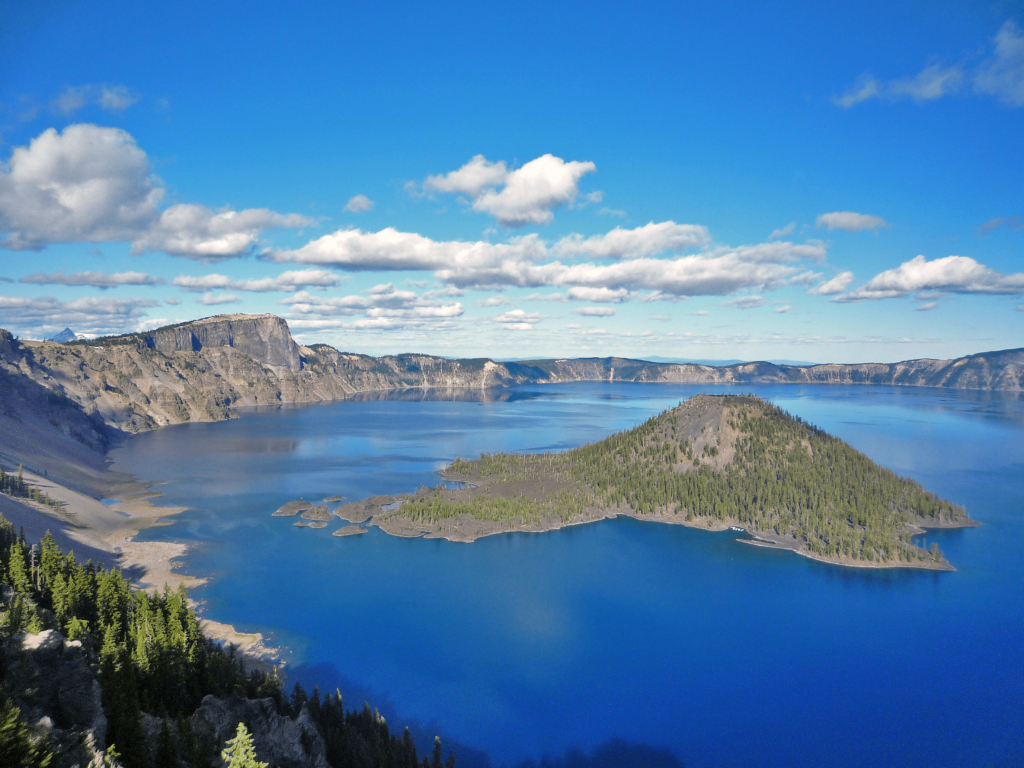The Ultimate Guide: Crater Lake National Park
Crater Lake National Park is a beautiful and unique park located in southern Oregon. It has a deep blue lake that sits in the caldera of an ancient volcano. The park has a rich history and offers many outdoor activities for visitors to enjoy.
For a condensed view of the park feel free to check out rvResortScouts Crater Lakes National Park Information listing.
Park History / General Overview
The park was first established in 1902 by President Theodore Roosevelt. Before that, the area was used by the Klamath Tribe for hunting and fishing. The Klamath Tribe believed that the lake was a sacred place and that the volcano was a powerful spirit.
The volcano, Mount Mazama, erupted about 7,700 years ago. The eruption caused the volcano to collapse, forming the caldera that we see today. Over time, rain and snow filled the caldera, forming the deep blue lake that we see today. The lake is the deepest in the United States, with a depth of 1,943 feet.
The park offers many outdoor activities for visitors to enjoy. Visitors can hike on over 90 miles of trails, take a boat tour of the lake, or have a picnic by the lake. The park also offers ranger-led programs, and visitors can learn about the park’s geology, wildlife, and history.
Crater Lake National Park is a must-see destination for nature lovers. The park’s deep blue lake, surrounded by beautiful landscapes, provides a unique and peaceful experience. The park’s history and natural beauty make it a great place to visit for a day or a week.
Getting Oriented
The park is divided into two main sections: the caldera and the rim. The caldera is the area around the lake and the rim is the area around the outside of the caldera. Both sections offer different experiences and activities for visitors to enjoy.
The caldera is the main attraction and offers many hiking trails, boat tours, and picnic areas. Visitors can take a boat tour of the lake on the park’s tour boat, the “Rim Village.” The boat tour takes visitors around the lake and offers great views of the lake and the surrounding area. Visitors can also hike down to the lake on the Cleetwood Cove Trail. This trail is steep and strenuous, but it offers beautiful views of the lake.
The rim offers many lookout points and trails for visitors to enjoy. Visitors can drive on the Rim Drive, which is a 33-mile road that circles the lake. The Rim Drive offers many lookout points and visitors can stop and take in the views. Visitors can also hike to the top of Watchman Peak or Garfield Peak for great views of the lake and surrounding area.
Visitors can also take short walks on the Discovery Point Trail, that offers views of the lake, Wizard Island and Phantom Ship.
Crater Lake Park offers a variety of experiences for visitors. Whether you want to hike, take a boat tour, or just take in the views, the park has something for everyone. It is important for visitors to plan their trip accordingly and decide which areas of the park they would like to see and what activities they would like to do.

Crater Lake National Park Essentials
The park is located in southern Oregon. The closest major city is Medford, Oregon, which is about 60 miles away. Visitors can get to the park by car, bus, or train. The park is open year-round, but some roads and facilities are closed in the winter due to snow.
The park entrance fee is $30 per vehicle and $25 per motorcycle. The park also offers an annual pass for $55. Visitors can purchase the park pass at the park’s entrance station or online. It is important to note that the park pass is valid for seven consecutive days and covers both the vehicle and its passengers.
The park has a visitor center that is open year-round and offers information on the park, maps, and books. Visitors can find information on the park’s history, geology, wildlife, and trail conditions. The visitor center also offers ranger-led programs, such as guided hikes and talks.
Visitors should also be aware of the park’s rules and regulations. Visitors should not feed the wildlife and should keep a safe distance from animals. You should also respect the park’s natural resources and pack out all trash. Campfires are only allowed in designated areas and visitors should check for fire restrictions before their trip.
Thing You Need to Know
When planning a trip to Crater Lake National Park, there are some things that visitors should know to make the most of their trip.
What to Pack: Visitors should pack warm clothing, as the park is at a high elevation and can be cool even in the summer. Visitors should also pack a rain jacket, as the park can have sudden rainstorms. Visitors should also pack sunscreen, a hat, and insect repellent.
Amount of Food Needed: Visitors should plan to bring enough food for their trip. However, the park does have a café and a store. Visitors should also bring enough water for their trip.
Hiking Gear: Visitors should wear sturdy hiking shoes and bring a daypack with enough water, food, and a first aid kit. Visitors should also bring a map and compass.
Animals in the Area: Visitors should be aware that the park is home to many animals, including bears, deer, and elk.
Cost of Trip: The park entrance fee is $30 per vehicle and $25 per motorcycle. The park also offers an annual pass for $55. Visitors can purchase the park pass at the park’s entrance station or online.
Family Activities: The park offers many family-friendly activities, such as hiking on easy trails, taking a boat tour of the lake, and having a picnic by the lake.
Conservation: The park is home to many unique and endangered species, and visitors should be aware of the park’s conservation efforts. Visitors should respect the park’s natural resources and pack out all trash.
RV Dos and Don’ts: The park offers RV camping in two campgrounds: Mazama Campground and Lost Creek Campground. Visitors should be aware that RVs are not allowed on the Rim Drive and that the park has strict rules about RV hookups.
Best Hikes Within Crater Lake National Park
There are many hiking trails within Crater Lake that range from easy to strenuous. The park’s hiking trails offer great views of the lake and surrounding area. Here are 5 of the best hikes in the park:
- Rim Drive – This is a 33-mile road that circles the lake and offers many lookout points. Visitors can stop at different viewpoints, such as the Watchman Overlook, and take in the views of the lake.
- Cleetwood Cove Trail – This trail leads down to the lake and is the only trail that goes to the lake. It is steep and strenuous, but it offers beautiful views of the lake. Visitors can also take a boat tour of the lake from Cleetwood Cove.
- Garfield Peak – This trail is a moderate hike that offers great views of the lake and surrounding area. The trail takes visitors to the top of Garfield Peak and offers panoramic views of the lake.
- Watchman Peak – This trail is a short hike to the top of Watchman Peak and offers great views of the lake and surrounding area. The trail is a bit steep, but it is worth it for the views.
- Pinnacles Trail – This trail is a moderate hike that takes visitors through a volcanic landscape of spires and cliffs. The trail offers great views of the surrounding area and visitors can see the different layers of volcanic ash and pumice.
Hikers should be aware that weather conditions can change quickly in the park. Hikers should be prepared for varying weather conditions, and bring enough water, food, and warm clothing. It is important that hikers be aware of their surroundings and stay on designated trails.
Accommodations
Crater Lake National Park offers two campgrounds: Mazama Campground and Lost Creek Campground. Both campgrounds have flush toilets and drinking water. Mazama Campground has 214 sites and is open from late June to early September. Lost Creek Campground has 16 sites and is open from late June to early September. Backcountry Camping is also allowed in the park with a permit.
Mazama Campground offers a variety of campsites, including tent and RV sites. The campground has a store, a café, and a laundry. The campground also has a shower and a coin-operated laundry. Visitors can make reservations for the campground online or by phone.
Lost Creek Campground is a more rustic campground, with no RV hookups. Visitors can make reservations for the campground online or by phone.
Backcountry camping is also allowed in the park, with a permit. Visitors can apply for a backcountry permit at the park’s visitor center. Backcountry camping is a great way to experience the park’s wilderness and visitors should be aware of the park’s backcountry rules and regulations.
Visitors should be aware that the park does not have any lodging facilities and that the nearest hotel is located in the town of Prospect, Oregon. Visitors should also be aware that the park is located in a remote area and that cell phone coverage is limited.
Safety
Crater Lake National Park is a safe place to visit, but visitors should be aware of the park’s rules and regulations. Hiking on trails can be dangerous. Be ready for wet or snowy conditions, making the trails slippery. Visitors should also be aware of the weather and dress accordingly. The park does have a trained search and rescue team for those rare occasions.
Visitors should always be prepared for the unexpected and carry a basic first aid kit and a map and compass. You should also let someone know of your plan and expected return time before going on a hike. Visitors should be aware of the park’s wildlife and keep a safe distance from animals. The park has strict regulations against feeding wildlife, and it can be dangerous for both visitors and animals.
Visitors should also be aware of the park’s fire regulations and only have campfires in designated areas. It is important to check for fire restrictions before their trip. Visitors should also be aware of the park’s “pack it in, pack it out” policy, which means visitors should pack out all trash.
Visitors should also be aware of the park’s water sources. Treat or filter water before drinking it. Visitors should also be aware of the park’s bear storage regulations and store their food properly.
What’s In The Surrounding Area
Visitors can find many activities to do in the surrounding area, such as hiking, fishing, and sightseeing. Oregon is a thriving state with plenty of activities to choose from.
The town of Klamath Falls, Oregon is located about 30 miles south of the park and offers many activities for visitors. Visitors can go hiking, fishing, and sightseeing in the town. Visitors can also visit the Klamath County Museum, which has exhibits about the history of the area.
The town of Medford, Oregon is located about 80 miles north of the park and offers many activities for visitors. Visitors can go hiking, fishing, and sightseeing in the town. Visitors can also visit the Rogue Valley Roses, which is a rose garden that has over 2,500 varieties of roses.
The town of Ashland, Oregon is located about 85 miles north of the park and offers many activities for visitors. Visitors can go hiking, fishing, and sightseeing in the town. Visitors can also visit the Oregon Shakespeare Festival, which is an annual festival that has plays by William Shakespeare.
The town of Bend, Oregon is located about 150 miles east of the park and offers many activities for visitors. Visitors can go hiking, fishing, and sightseeing in the town. Visitors can also visit the High Desert Museum, which has exhibits about the natural and cultural history of the area.
Crater Lake National Park Wrap Up
Overall, the park is a beautiful and unique area that offers many outdoor activities for visitors to enjoy. The park has a rich history and is home to the deepest lake in the United States. Visitors can take a drive around the lake, hike on the park’s trails, or enjoy a picnic with a view of the lake. The park offers two campgrounds and backcountry camping for visitors to enjoy. The surrounding area of the park also offers many activities such as hiking, fishing, and sightseeing.
It is important for visitors to plan their trip accordingly and be aware of the park’s rules and regulations. Visitors should also be aware of the park’s safety guidelines and be prepared for the unexpected. The park’s search and rescue team is trained to handle emergencies and visitors should not hesitate to contact them if they need help.


